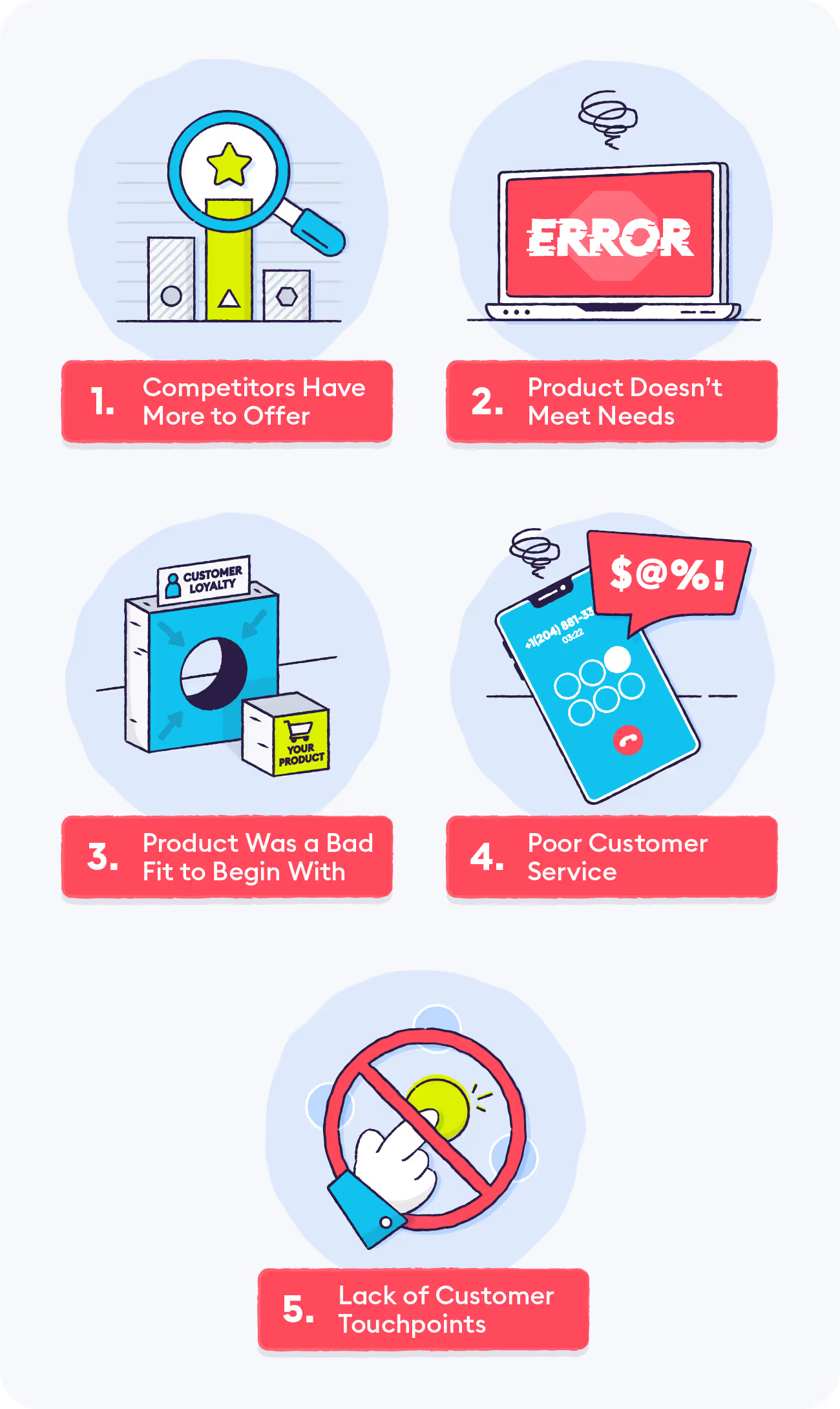Customer churn is one of the most vital data points for businesses to track. After all, retaining happy customers is the primary way most companies succeed, and nearly all marketing and customer service initiatives are focused on fixing or improving the customer experience. Customer churn analysis helps you identify key stages in the customer journey where people are falling off, allowing you to pinpoint specific strategies to improve their interactions with your brand and improve brand loyalty.
What is Customer Churn?
Customer churn is the rate at which customers leave your company. This could be for a variety of reasons, such as switching to a competitor, canceling their subscription due to poor customer service, stopping all contact with a brand because of too few touchpoints, etc. Customer churn analysis is important for obvious reasons: lost customers mean a direct loss of revenue.

And you might think that you can just make up for lost customers by appealing to new ones, but studies have shown that the CAC (customer acquisition cost) for gaining a new customer can be anywhere from five to 25 times more expensive than keeping an existing customer!
The Basic Churn Model
At its core, the churn model is a simple equation: # of churned customers/total customers = customer churn. It’s important to have this basic understanding of the churn model so you can find value in your churn analysis results and know what they actually mean.

However, the churn model becomes much more difficult when your business starts to scale, and you begin to model specific factors into the equation such as seasonality and customer segmentation. Once your business reaches a certain size, you’ll likely need the help of data analysts to help you account for all the different variables you’ll be tracking.
The good news is, you don’t have to be a professional data analyst to understand why customers leave your business and what you can do about it. Below are five of the most common reasons customers leave your business as uncovered by customer churn analysis.
The 5 Main Reasons Customer Churn…

1. Competitors Have More to Offer
If a competitor has a product similar in quality and offerings to your own but it’s set at a lower price, you can hardly blame your customers for going with the more affordable option. Though competitor analysis is rarely that cut and dry, it’s critical that you keep an eye on what your competitors are doing to appeal to your shared audience and match or exceed their efforts. Companies that are able to be flexible and reactive to customer needs will almost always win out over static, unchanging businesses.
2. The Product Doesn’t Meet Customer Needs
This is probably the reason you think of first when it comes to churn analysis. If your product doesn’t live up to customer expectations, they are going to be disappointed with their purchase and churn. The reason a product doesn’t meet customer needs can come from a variety of factors and doesn’t necessarily mean that your product isn’t up to snuff, though of course, this can be a major factor. Sometimes a customer may not understand how to use your product properly, leading them to think it’s low-quality, when in fact it’s the instructions and on-boarding process that need improvement.
3. The Product Wasn’t a Good Fit to Begin With
Another factor you may uncover in your churn analysis is that the customer was actually not a good fit for the product at all. This can be a particularly frustrating situation as the marketing resources required to reach new customers, such as social advertising and email campaigns, can be quite costly and end up being a waste when the customer immediately churns. This is why it is so important to conduct in-depth market research about your ideal customer base ahead of time.
4. Poor Customer Service
This is another one of the obvious reasons that come to mind for why customers leave your business. Though this is becoming less of an issue these days as AI-powered chatbots allow for more seamless service, a company with a sub-par customer service team is almost inevitably going to deal with churn and fail to close the customer feedback loop.
There’s nothing more frustrating than being unable to make changes to your account or get in contact with someone about an issue, and many customers would rather stop interacting with your company altogether than deal with jumping through customer service hoops. In fact, one study found that over half of customers would never do business with a company again after just one negative customer service experience.
5. Lack of Touchpoints After Conversion
Maybe your customers aren’t dissatisfied with your product or customer service, perhaps they’ve just forgotten about you because you’ve forgotten about them. After someone converts, you can’t just assume they’ll remain a loyal customer until the end of time. It’s important to show them that you value their patronage, you remember them, and you care about keeping them happy. You can follow up with customer touchpoints in a variety of ways, from free birthday gifts to emailed discounts.
...And 5 Steps for Conducting Churn Analysis
Now that you understand the main reasons that cause customers to churn, here are the places you can look and the strategies you can utilize to conduct customer churn analysis across your business.

1. Evaluate Competitor Strengths and Weaknesses
Like we discussed earlier, if a competitor has a strictly better pricing structure than you while maintaining the same level of quality, then it’s a no-brainer for a customer to churn in favor of your competitor. Though things are rarely that simple, the principle is still the same. You should be constantly researching your competitors to identify areas where they are outperforming you and work to strengthen those aspects of your own business to reduce customer churn.
Not only should you be pinpointing competitor strengths, but also places where they are vulnerable and weaker in their offerings than you so you know where to take advantage of your own strengths and potentially bring their customers over to you.
2. Investigate Support Tickets for Repeat Issues
One of the primary aspects of your churn analysis strategy should be to identify any frequently-occurring customer complaints. Whether your customer service team uses support tickets, chatbots, or another way to track issues, this should be one of the first variables you investigate. These complaints come from customers who were upset and motivated enough to make the effort to reach out, indicating that there could be a significant shortcoming in your product that you weren’t aware of. You should be compiling and categorizing this feedback on a regular basis, and addressing any repeat issues ASAP.
3. Apply Sentiment Analysis Across Channels
To take the previous churn analysis strategy to the next level, you should be applying sentiment tracking and analysis across all of your channels, including customer support tickets, online reviews, social media mentions, and anywhere else customers communicate about your brand. By using AI-powered text analytics to compile customer feedback on a large scale, you can make more informed, data-backed decisions about what exactly is causing customers to churn. Learn more about Chattermill’s advanced CX tracking capabilities and how they can help your brand conduct customer churn analysis.
4. Discover Customer Drop-Off Points and Corresponding Changes
Even if users of your product aren’t leaving a specific review or contacting customer support about certain issues, you can use churn analysis to figure out if there were specific changes that caused them to leave. For example, a beachwear company might experience a significant churn in the off-season, as not many people are going to be shopping for a new swimsuit in the winter.
Or perhaps your company recently implemented a new AI chatbot, and at the same time saw a high level of customer churn. This could indicate that customers are having problems with the new technology. By pinpointing changes within the business and corresponding churn, you will be able to discover things about your brand that customers clearly don’t like, even if they’re not specifically saying so in reviews.
5. Utilize Customer Segmentation for More In-Depth Analysis
Not all customers are the same, so to make your churn analysis that much more insightful you should also be segmenting your customers by age, gender, income, subscription type (if applicable), history with your product, and any other relevant data points. This way, you can make sure that your customer outreach is as effective as possible and addressing the unique needs of each segment.
You don’t want to treat a brand new customer the same way as you would a 10-year, enterprise-level subscriber. Segmenting customers can also help you identify upsell opportunities if you are able to track a pattern for which types of customers are more likely to request additional features at specific times in the customer journey.
Take a look at the visual below for consolidated takeaways on what causes churn and ways you can conduct customer churn analysis:

Maintaining happy, loyal customers is the key to any successful business, and Chattermill’s advanced, AI-powered text analytics and sentiment analysis tools can help you conduct churn analysis to make sure your customers are staying satisfied. Contact Chattermill to set up a demo and see it in action.
Churn Analysis: FAQs
What is churn analysis?
Churn analysis is the process of studying customer behavior and data to understand why customers stop doing business with a company. It helps identify patterns that lead to churn and provides insights to prevent future losses.
Why is churn analysis important?
Churn directly impacts revenue and growth. By analyzing why customers leave, businesses can address root causes, improve retention strategies, and strengthen long-term customer relationships.
What are the main causes of customer churn?
Common causes include poor customer experience, lack of product-market fit, high prices, better competitor offerings, and insufficient customer support. Identifying which factors apply to your business is key to reducing churn.
What metrics are used in churn analysis?
Key metrics include churn rate, retention rate, customer lifetime value (CLV), Net Promoter Score (NPS), and engagement data such as login frequency, purchase frequency, or support ticket history.
How is churn analysis conducted?
Churn analysis involves collecting customer data, segmenting users, and looking for trends among those who leave. Advanced methods include predictive analytics and machine learning models to forecast which customers are most at risk.
Can churn analysis predict future customer behavior?
Yes. Predictive churn analysis uses historical data to forecast which customers are likely to leave. This allows businesses to intervene proactively with personalized offers, support, or engagement campaigns.
How can businesses reduce churn using analysis?
By acting on insights, businesses can improve onboarding, personalize communication, enhance customer support, and offer retention incentives. Addressing pain points quickly helps reduce the likelihood of churn.
Which industries benefit from churn analysis?
Churn analysis is especially valuable in subscription-based industries like SaaS, telecom, streaming, and e-commerce. However, any business that depends on repeat customers can benefit from understanding and reducing churn.















